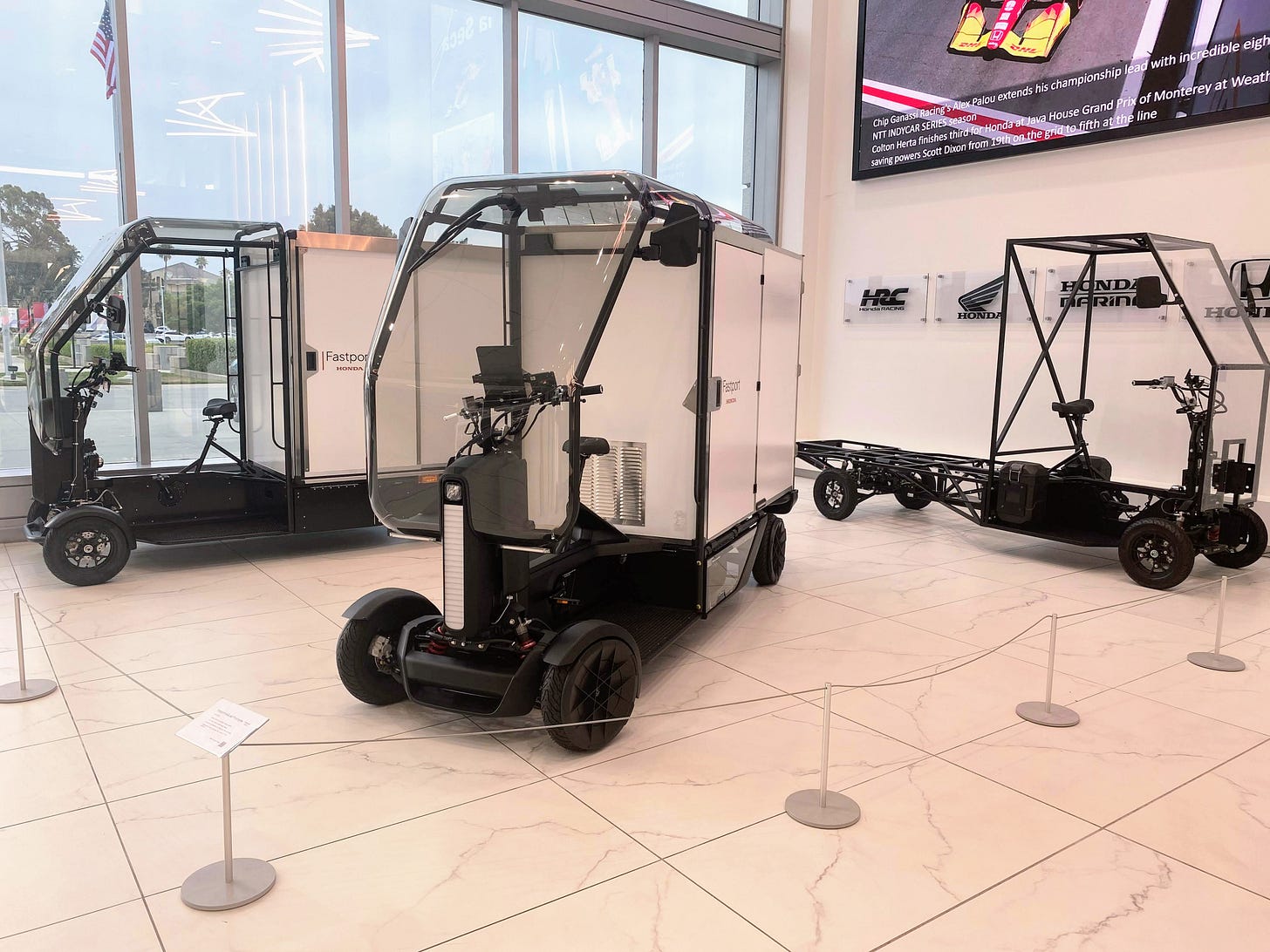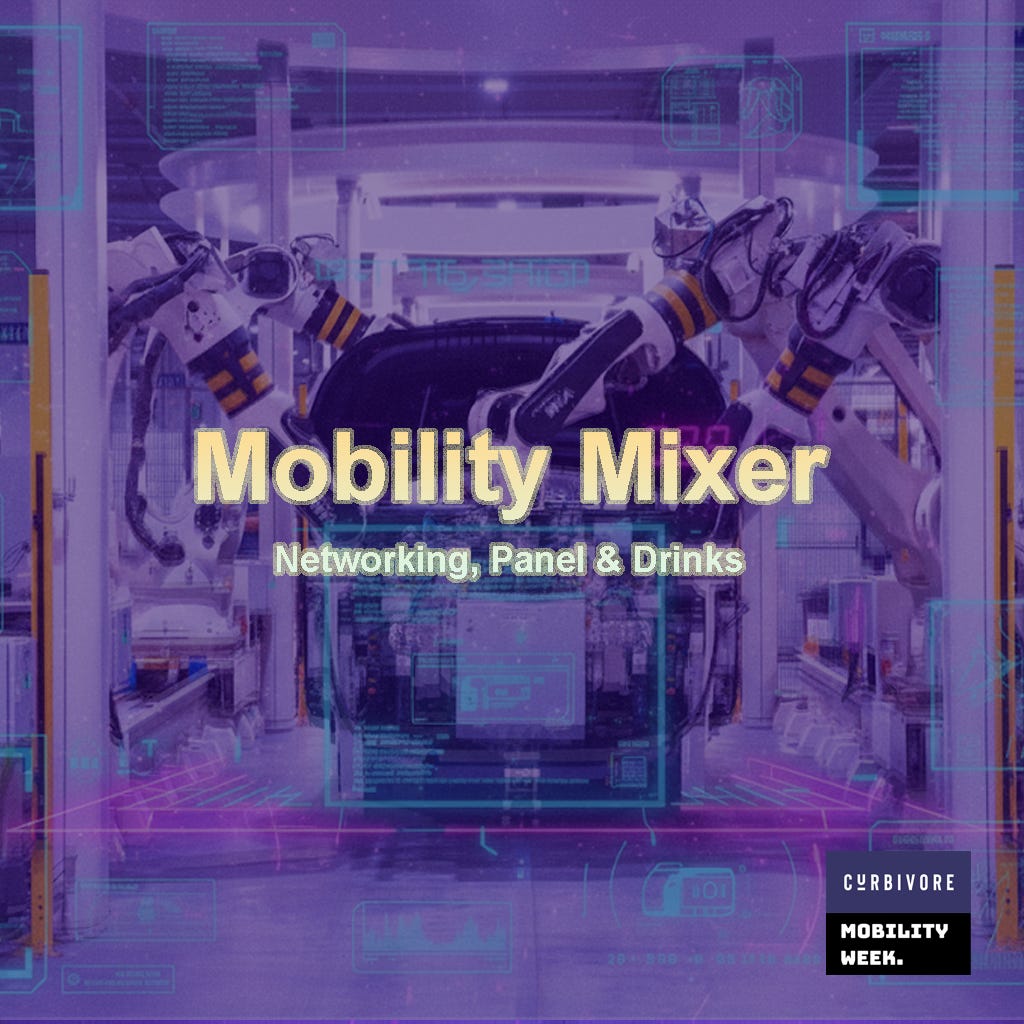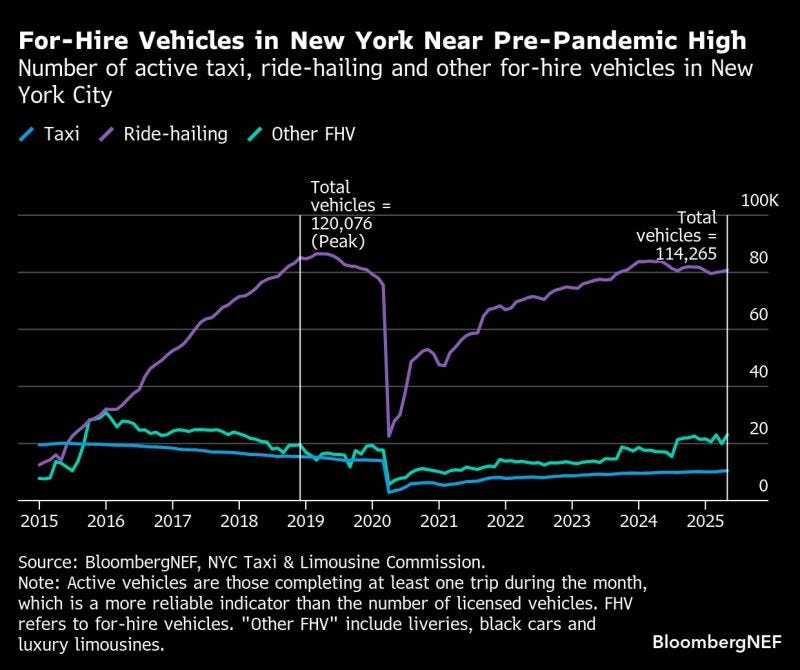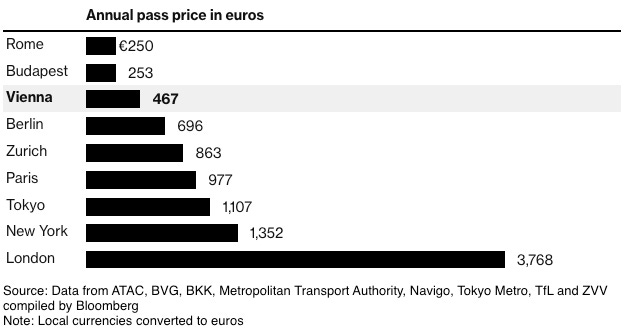Honda Fastport’s eQuad Aims to Right-Size the Streets
From N600 to eQuad: Honda Shrinks to Grow - Test Ride & Review
Entering Honda’s North American headquarters, the first thing you see is a jewel-box museum of the automaker’s legacy cars and trucks. After admiring their gleaming paint jobs, the next thought hits: damn, those cars were small. The N600, the first auto that Honda sold in the United States, was less than 10 feet long; not even two thirds the size of a present-day Civic, let alone the monstrous SUVs and pickups that maraud our streets.
But while car sizes have bloated ever upwards in recent years, Honda is hoping to reverse course, with the company’s “second founding” promising a new future for smaller and more sustainable vehicles. With that in mind, the company invited me to kick the (pint-sized) tires on their new Fastport eQuad prototype.
Fastport, set up as a new subsidiary within the OEM, calls the eQuad a micromobility vehicle, but don’t let that conjure up thoughts of a shared scooter bombing down the sidewalk. This is a professional-grade machine, meant for hauling cargo in urban centers. The larger of the two variants is 144 x 84 x 48 inches (bigger than that O.G. N600) and can haul up to 650 pounds at 12 MPH for roughly 23 miles.
The eQuad definitely looks sharp, while the steady refinement of the concept shows the company knows how to polish a form factor. Other corporations have tested similar vehicles — Curbivore attendees may recall Fernhay’s eQuad — but Fastport thinks Honda’s OEM pedigree gives it an edge. The eQuad shares components like its battery pack (MPPs) and chassis (ATVs,) while overall brand familiarity may help new customers feel more comfortable jumping to the novel form factor. On the flip side, Fastport’s opting not to sell these things through Honda’s dealer network (who, in my experience, would likely have no idea what to do with a product like this,) instead offering them via an all-in-one “Fleet as a Service” model.
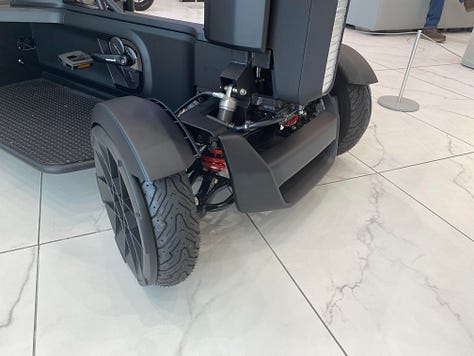
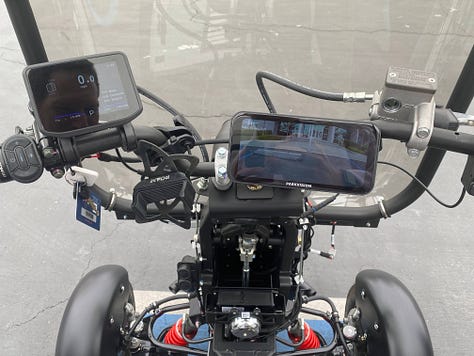

The Test Drive
After the team’s done drilling impressive stats into my head, it’s time for the test drive. Climbing over the bicycle-style seat, the eQuad immediately feels like a cross between a bike, an ATV and a tiny truck. Despite appearances, pedaling isn’t daunting. In fact, the “pedaling” motion is about as strenuous as pressing down on a car’s accelerator; even with the system set for minimal assistance, the crank moves with barely any pressure. Suffice to say, delivery workers will still be getting their workouts from loading and unloading boxes, not from huffing and puffing up any hills.
After that initial test, it’s time to put the eQuad through its paces, which it handles with remarkable grace. Maneuvering is easy, although the turning-radius leaves a bit to be desired. Even backing up is breezy. And while the motor may cut out at 12 miles per hour, I found you could get it going considerably faster than that on a straightaway. Given that the eQuad is intended for operations in congested urban environments, it seemed plenty fast for the job.
Speaking of the job, loading and unloading looked to be easy as well, with plenty of configurable storage space and all sorts of doors and roll gates. Fastport showed off a few different configurations, noting that different trial customers (all top secret, sadly) had asked for divergent variations and placements.
Where To?
As much as I enjoyed my test drive, the whole cruise took place in a corporate facility separated from any real traffic. All the while, I found myself thinking “how comfortable would I be driving this next to a big rig?” That begs the question of what’s the addressable market for the eQuad… I can see it easily taking off in Europe and Asia, but what about America?
American Honda’s hometown of Torrance is an instructive example. Located about 15 miles southwest of Downtown Los Angeles, this ethnoburb is the quintessential “balanced city,” defined by its jumble of commercial, residential and industrial uses. At the city’s western edge, small and dense lots greet the sea, and tight, winding roads with good bike infrastructure would be the perfect spot to take the eQuad for a spin. The city’s Frederick Law Olmsted Jr.-designed downtown is also quite friendly to small vehicles, thanks to a tight street grid interspersed with soba restaurants and breweries.
But in between those two neighborhoods there’s a big ol’ sprawl of mid-century suburbia. (These are the Plains of Id, for you Reyner Banham fans.) Yes, in classic SoCal style the lots are still densely packed and the street stays gridded in a relatively urban fashion, but the wide roads encourage speeding. Tougher still is the city’s industrial quadrant on the northeastern side, where tank trucks scream down boulevards that go a half mile between stop lights.
Of course, Honda envisions these vehicles in the hands of fleet operators with a bevy of vehicles. If you’re UPS, you should be able to dispatch your standard truck to the industrial neighborhoods, while deploying an eQuad towards the beach bums (or say Portland’s James Beard Public Market, a use case that the Fastport team’s particularly interested in.) But as we’ve seen with New York City’s Microhubs trial, even once big logistics firms say they’re interested in using more urban-friendly mobility options, actually getting them to follow through is another thing. For better or worse, getting couriers to really adopt cargo bikes is going to take strict enforcement, of both the deliverers themselves, and of other road users that might get in the way.
Join Us in Detroit for Our Mobility Week Mixer on 9/23
Curbivore is kicking off Mobility Week with our Mobility Mixer: a lively evening of networking, a panel and drinks, hosted at Detroit TechTown, on September 23rd.
Top mobility investors from coast-to-coast will be convening alongside Michigan's foremost transportation, autotech and public-sector leaders for a lively discussion featuring Jonah Bliss, Greg Lindsay and Bloom Co-Founder Chris Nolte.
If you're a founder, funder, builder, OEM, mobility startup, investor, or just a friend of the curb... join us to celebrate Mobility Week with some West Coast flair.
HOT INDUSTRY NEWS & GOSSIP
Is NYC ready for robotaxis? The number of taxis and ridehailing vehicles on New York City streets is nearing a record high, leaving policymakers with some interesting choices as Waymo and other operators prepare for operations in the Big Apple. Given that AVs haven’t shown much improvement to stats like deadheading or occupancy, will politicos choose to crank up congestion pricing to keep streets moving? The latest data shows the tolling program has reduced traffic by 12%. Sounds like there’ll be plenty to talk about at our Urban Autonomy Summit — 10/8 in Brooklyn.
In other autonomy news: Uber and Momenta plan to test AVs in Germany starting next year. Tesla’s not-quite-autonomous TNC program wants to expand to Bay Area airports. Lyft and May Mobility launched their Atlanta pilot program, while Zoox opened its Vegas service to public riders. Munich-based Fernride raised €18M as it pivots to autonomous defense tech amid a rearming Europe (what was it that President Eisenhower once said?) And Serve Robotics scooped up the assets of Phantom Auto and Voysys, coming hot on the heels of its Vayu acquisition.
Squint and you’ll see the Olympics… Culver City Transit just launched Line 99 - Sofi Express bus service, offering riders a quick link to the Inglewood stadium during football games. With the Olympics now three years away, think of this is a preview of the special shuttles that’ll ply SoCal’s roads in 2028. And speaking of ‘28, we’ve got a bit of gossip: a Metro infrastructure contractor tells us the VA Station — meant to be the western terminus for the D Line heavy rail extension, will likely not be done in time for a 2028 opening. Oops!
How do you say “one more lane bro” in German? Berlin just opened a new section of the A100 freeway, tearing a retrograde path through a number of inner-city neighborhoods. In utterly predictable fashion, it appears to have only made traffic worse, so much so that bus service has been suspended in certain neighborhoods due to cascading congestion bogging down the whole system.
Transit starts and stops: Illinois shifts money around to keep the CTA solvent through mid-2026, while after much “will they or won’t they” CA Governor Newsom approved a $750M loan to troubled Bay Area transit operators. Vancouver’s Skytrain extension has begun elevated guideway construction. Seattle’s started testing the first light rail to ever cross a floating bridge. And Vienna is ditching its dirt-cheap Euro-a-Day transit pass; see comparisons below (oof, sorry London commuters.)
Keep your eyes on that ticker tomorrow… Via Transportation ($VIA) is set to go public on Friday, targeting a valuation of $3.5 billion. Recent IPOs have had juicy pops; we’ll see if retail enthusiasm extends towards less sexy sectors. If so, expect to see a whole lot more mobility-related public offerings follow.
You’re gonna want to watch this: Meet Hangkeun Kim, who roams the streets of Seoul looking for manholes, sewer grates and other bits of curbside infrastructure that are just slightly misaligned. He springs into action in super hero fashion, nudging those unloved metal pieces to where they belong.
Bus-ted! Earlier this month, Santa Monica, CA started automatic camera-based bus lane enforcement, looking to ticket scofflaws that block the Big Blue Bus; they’re just the latest SoCal transit agency to turn to Hayden AI for enforcement. And speaking of cameras, Nexar and Flock look to be teaming up on ALPR.
And now, a bit about Brussels… Anyone that’s ever visited Belgium knows it’s a bit more car-crazed than your average European nation. Much of that ties to the prevalence of “salary cars” — around 50% of new car registrations are tied to workers receiving free auto leases through their employers, because while salaries are taxed highly, in-kind benefits are not. That’s why it’s no surprise to see Brussels-based Lizy raise €75M ($88M) for used car leasing. In greener news, Upway and Lease a Bike are making headway with getting employers to also offer refurbished e-bike leases as a corporate perk. Those kind of benefits can be very sticky: witness the uproar in Finland after the gov’t tried to lessen related tax incentives.
In case you need some last second mascara: The 3PDs have rapidly expanded from delivering food and groceries to offering last-second delivery of just about anything. While some verticals strike me as stretches (who needs emergency golf supplies?) this new partnership with Sephora seems like a winner: now Uber users don’t need to ever worry about running out of lipstick or skin cream right before heading out.
A few good links: ZM Trucks opens battery-electric assembly plant in Fontana, CA. Chinese EVs that look suspiciously like western EVs. Meanwhile, Beijing is trying to tamp down its EV price wars. Commuters turn to two-wheelers as Tube strike roils London. So much for populism: Trump Admin cancels plan to make airlines pay passengers for disrupted flights. Hopefully not while they’re driving — Uber offers Indian drivers side gigs as data labelers. NYC brings bus lanes to Flatbush Ave but pauses Crown Heights bike lanes and UWS metered parking reform. EchoStar sells spectrum to SpaceX for $17B while JetBlue picks Amazon’s Project Kuiper for fly-fi and ReOrbit raises €45 million to give Europe satellite sovereignty. Hyundai’s eVTOL project looks awfully grounded. Tesla market share falls to lowest since 2017. Amazon buys stake in Colombian deliverer Rappi. San Diego looks to overhaul parking. European OEMs look to go “on the offensive.” CARB reopens Hybrid and Zero-Emission Truck and Bus Voucher Incentive Project to new funding requests. NYC City Council overrides mayoral veto to close Instacart loophole. 20 years after Katrina, NOLA’s economic trajectory is split along racial lines. UK eyes hiking parking rates for big SUVs. Feds raid GA. Hyundai plant filled with Korean workers training and observing American auto workers — how exactly are we supposed to reindustrialize? DOJ sues Uber over disability discrimination. The grand bargain: TNC drivers in California allowed to unionize in return for state lowering insurance minimums.
See you in Detroit?
- Jonah Bliss & The Curbivore Crew



